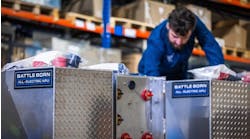Hearing the latest economic announcements reminded me of the punch line of the announcement from the cockpit during the “world's first fully automated flight. Sit back and relax; nothing can go wrong-ong-ong…”
Lately, the economy has been cruising smoothly with no turbulence in sight. Real (net of inflation) gross domestic product has hummed at a healthy 3% growth rate or better each quarter. Every six to eight weeks Captain Greenspan and the crew of the Federal Reserve's Federal Open Market Committee announce another quarter-point increase in the short-term interest rate target, and long-term bond markets continue snoozing. In fact, the 30-year fixed mortgage rate actually dropped in each of the first six weeks of 2005.
Inflation does not appear to be gaining altitude. Even diesel prices have calmed down, staying within a narrow (albeit historically high) range of $1.93-$1.99 per gallon from mid-December through early February.
Back on the ground, demand for trucking seems to be growing well from every sector. Residential construction shot up 14% in 2004, while private nonresidential and public construction each grew by more than 3%, with bigger gains likely in 2005. Factory orders have been moving up at a good clip. Exports have started to pick up, as the drop in the dollar against the yen, Canadian dollar, and European currencies have made U.S. sellers more competitive at home and abroad. Personal income continues to grow a bit faster than the rate of inflation. Consumer spending has advanced steadily.
With so much good news, it's a good time to contemplate what could go wrong, what you could do now to protect yourself, and whether the risk is great enough to make precautions worthwhile.
The most likely problem to occur is probably another flare-up of fuel prices. Fortunately, many carriers have been able to share the risk of these price spikes with their customers through fuel surcharges, which have been more readily accepted than in past periods of volatility.
Beyond rising petroleum prices, there is the risk that inflation will take off or that key inputs will be hard to get. For carriers, that risk could show up in equipment and labor costs. Last year, trailer buyers got a taste of inflation, as the producer price index for trailers jumped 9.7% due to a huge run-up in steel and aluminum costs. You can't control the price of raw materials, but if you know they're rising in price, you may want to accelerate your equipment orders or lock in prices earlier.
Meanwhile, trucking employment rose almost 3% from January 2004 to January 2005, or nearly double the rate for nonfarm payroll employment. With the overall unemployment rate gradually working its way down, there's a distinct possibility that fleets will be scrambling much harder to find and retain drivers and mechanics by the end of 2005.
Staff recruitment and retention obviously requires a long-term strategy. Now is the time to find out what makes your workers stick around — or leave at the first opportunity. Establish or strengthen your contacts with high schools, driver-training schools and other potential sources. Compare your compensation and personnel policies to the competition in both for-hire and private trucking.
The bottom line: The prospect of fuel price spikes, inflation, or labor shortages may seem remote in 2005. But it has been said that luck happens to those who are prepared. To steal a line from another airplane joke, this is the time, while the economic jet is on autopilot, to make sure you've grabbed a parachute and not a backpack.


